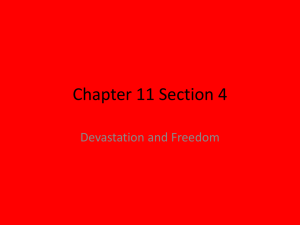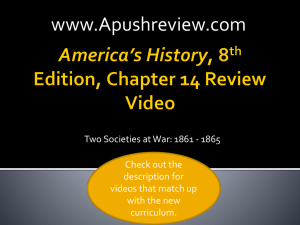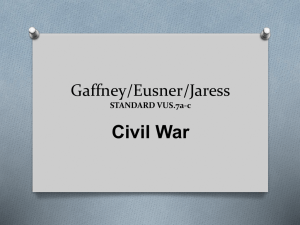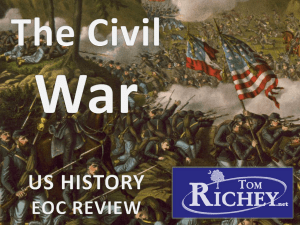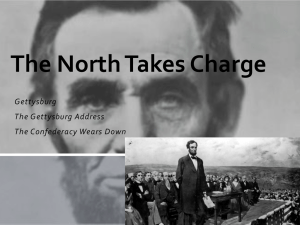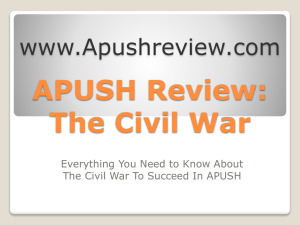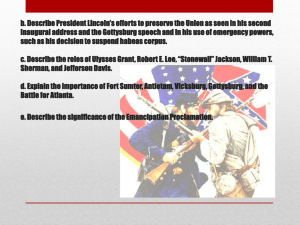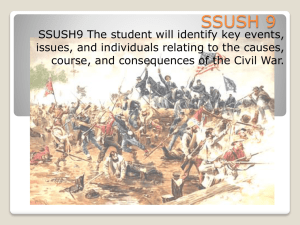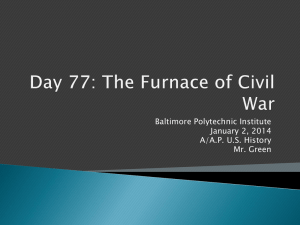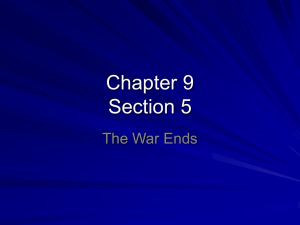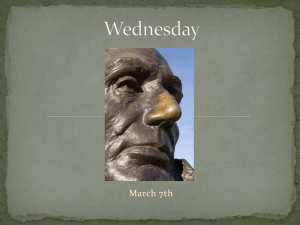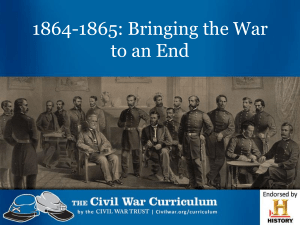Ch.11-sec-4-5-2
advertisement
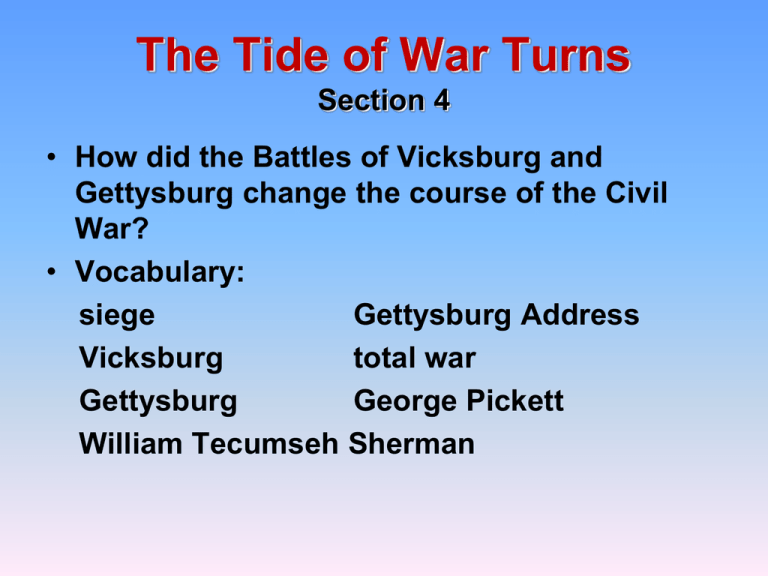
The Tide of War Turns Section 4 • How did the Battles of Vicksburg and Gettysburg change the course of the Civil War? • Vocabulary: siege Gettysburg Address Vicksburg total war Gettysburg George Pickett William Tecumseh Sherman Turning Points of the War Union Victory at Vicksburg Main Idea: After two years of war, the Confederacy still had strongholds at Port Hudson, Louisiana, and Vicksburg, Mississippi. Lincoln proclaimed that Vicksburg was the key to reaching the war’s end. A Turning Point in the East Main Idea: While Union troops advanced in the West, the situation was different in the East. Despite claiming victory at Antietam, Lincoln soon replaced General McClellan for failing to pursue the retreating Confederates. McClellan’s replacement, General Ambrose Burnside, headed south, hoping to win a decisive victory. The Union Presses the Advantage Main Idea: The Union victories at Gettysburg and Vicksburg dealt a severe blow to the Confederacy. Lee’s troops were in retreat and the Mississippi was in Union hands. The Confederacy would still win some victories, such as that at Chickamauga, Georgia, in the fall of 1863. In general, however, the situation of the South was dire. Continued… Battle of Fredericksburg General McClellan replaced with Ambrose Burnside Burnside attacks Lee in VA by charging into Confederate gunfire Union casualties 13,000 Battle of Chancellorsville Burnside resigns Joseph “Fighting Joe” Hooker takes over for North Lee split forces to counter Hooker, approaching from the rear; builds fires in camp Lee and Jackson Chancellorsville May, 1863; On the second day, Stonewall Jackson attacked on right of Hooker Jackson scouting at night and is hit by own troops; arm amputated; died Battle of Gettysburg North at low point due to losses Lee weakened by blockade and lack of supplies Lee hoped North would give up if he won in Pennsylvania July 1, 1863 General George Meade, new Northern general Northerners held hills south of town; Cemetery Ridge Southerners held Seminary Ridge; field in between; General James Longstreet, Lee’s second in command He advised Lee not to attack the North’s strong position Lee orders the attack July 2, 1863 Meade brings reinforcements Little Round Top, undefended Maine soldiers under Colonel Joshua Chamberlain hold it and then attack with bayonets Saved Union army from retreat July 3, 1863 Lee opens with artillery barrage 15,000 Confederates attack Pickett’s Charge; cut up by Northern artillery; ½ casualties Gettysburg Bloodiest battle of war Union had 23,000 casualties South had 28,000 casualties July 4, 1863, Lee retreats to Virginia Vicksburg North wanted control of the Mississippi River General Ulysses S. Grant Several attacks failed Began a siege in May 1863 Surrender July 4, 1963 With the fall of Port Hudson, the South was split in two Turning Point Gettysburg and Vicksburg Mississippi River taken by North, cutting Confederacy in two Gettysburg Address Nov. 19, 1863 President Lincoln explained the meaning of the Civil War Freedom and equality belong to all TRANSPARENCY The Gettysburg Address •“Fourscore and seven years ago our fathers brought forth on this continent a new nation, conceived in liberty and dedicated to the proposition that all men are created equal. •Now we are engaged in a great civil war, testing whether that nation or any nation so conceived and so dedicated can long endure. We are met on a great battlefield of that war. We have come to dedicate a portion of it as a final resting place for those who died here that the nation might live. This we may, in all propriety do. But in a larger sense, we cannot dedicate, we cannot consecrate, we cannot hallow this ground. The brave men, living and dead who struggled here have hallowed it far above our poor power to add or detract. The world will little note nor long remember what we say here, but it can never forget what they did here. •It is rather for us the living, we here be dedicated to the great task remaining before us--that from these honored dead we take increased devotion to that cause for which they here gave the last full measure of devotion--that we here highly resolve that these dead shall not have died in vain, that this nation shall have a new birth of freedom, and that government of the people, by the people, for the people shall not perish from the earth." Grant Takes Command Lincoln must win battles to win the election of 1864 Grant plans to use North’s superior population and industry to wear down the South Battle of the Wilderness May 5, 1864 in Virginia Grant beaten, but moved south anyway No retreat Battle of Spotsylvania May 12, 1864 Northern losses were huge, with bodies piled four deep Again Grant moves his army further south Battle of Cold Harbor June, 1864, armies met eight miles from Richmond Large Northern losses Grant lost 7,000 Union soldiers in less than one hour QUICK STUDY Goals of Total War Sherman in Georgia Sherman wanted to seize Atlanta, a rail and industrial center 98,000 Union men Confederate General Joseph Johnston Battle of Kennesaw Mountain Atlanta Johnston wanted to delay Sherman until after the Nov. elections Mid-July, Sherman is near Atlanta Johnston replaced with General James Hood Hood engaged Sherman in several battles and lost thousands of men Sherman laid siege to the city In September the South’s army left Atlanta March to the Sea Some thought Sherman was mentally unstable He ordered Atlanta burned Cut a 300-mile long path of destruction Captured Savannah in Dec. Election of 1864 Lincoln and Andrew Johnson, Vice President McClellan, Democrat Capture of Atlanta helped Lincoln win reelection NOTE TAKING Reading Skill: Summarize A New Birth of Freedom Section 5 • What was the final outcome and impact of the Civil War? • Vocabulary: Thirteenth Amendment John Wilkes Booth Mathew Brady Land Grant College Act The War’s End and Impact The War’s Final Days Main Idea: In the summer of 1864, the Confederates made a desperate stand at Petersburg, a vital railroad center. Grant knew that if he captured Petersburg, he could cut all supply lines to Richmond. Therefore he applied his siege tactics to Petersburg and ultimately achieved victory. Richmond, then defenseless, was evacuated and set on fire. Why the North Won Main Idea: The Union victory was a result of several key factors. Northerners were able to take advantage of their greater technological prowess, larger population, and more abundant resources. The Union was also able to develop new advantages, particularly brilliant and fearless military leaders who were willing to do everything it took to win the war. Meanwhile, the South used up its resources, unable to call upon fresh troops and supplies. The War’s Lasting Impact Main Idea: The Civil War produced extraordinary levels of casualties and destruction. Also, social and political disillusionment on both sides fed economic greed. However, the Civil War managed to ease the history of disunity of in American political life and helped to cement federal authority. Siege of Petersburg Grant moved around capital of Richmond and attacks Petersburg In last two months, Grant lost 65,000 men Lee has trouble replacing casualties and waits Thirteenth Amendment Passed by Congress in February, 1865 Ratified by the states and became law on Dec. 18, 1865 Ended slavery in the U.S. End of the War Sherman moved through South Carolina, burning most houses Did not destroy North Carolina Appomattox Court House April 9, 1865 Lee met Grant and surrendered Grant offered food and ordered celebration by Northern troops ended NOTE TAKING Reading Skill: Recognize Sequence 1809 • Abraham Lincoln was born on February 12, l809 in a log cabin on the Kentucky frontier. • Lincoln was named after his grandfather. • His parents were Thomas Lincoln and Nancy Hanks. • He had one sister Sarah. 1834 • Lincoln, age 24, served in the state government of Illinois. • He was elected to the legislature as a Whig • He denounced slavery, saying it was "founded on both injustice and bad policy." 1836 • September 9, Lincoln received his law license • Is made a leader of the Whig party. • He first practices law in Springfield, Illinois. 1842 • November 4, Lincoln married Mary Todd. • Had four children Robert (1843-1926), Edward (1846-1850), William (1850-1862), and Thomas (18531871). 1860 • Lincoln is elected the 16th President of the United States • Is the first Republican to Be elected • Was a difficult time for Lincoln, since many Southern states did not agree with him on slavery • Declared they were not a part of the United States. 1861 • The South leaves the Union and the Civil war begins • Began with an attack on Fort Sumter • The U.S. struggled in The Civil war for four year, 1861-1865. 1863 • On January 1, Lincoln issues the final Emancipation Proclamation • Freed all slaves in territories held by Confederates • Emphasized the enlisting of black soldiers in the Union Army. 1864 • Lincoln is reelected President. • He won the election defeating Democrat George B. McClellan. • He received 55 percent of the popular votes and 2l2 of 233 electoral votes. 1865 • Civil War ends. • General Lee's troops were surrounded and on April 7, Grant called upon Lee to surrender. • The two commanders met on April 9, and agreed on the terms of surrender. Lincoln’s Assassination April 14, 1865, John Wilkes Booth shot Lincoln while he was watching a play Lincoln died the next day and Booth was killed in Virginia 1865 • On April 13, Lincoln attended a play at Ford's Theatre and was shot. • John Wilkes Booth, had shot the President. • Lincoln died on the morning of April 15, 1865. John Wilkes Booth NOTE TAKING Reading Skill: Understand Effects Effects of the War Both sides suffered great losses; more than half a million people died Union preserved Slavery abolished Economy: -Union costs $6 billion, Confederate costs $2 billion -Southern farms, factories, and railroads destroyed -Southern industry crippled -Confederate states lost two thirds of their wealth Two Important Acts • Homestead Act: 1862, Congress passed act, making western land available at a very low cost to those who would farm it. • Land Grant College Act: 1862, legislation that gave money from the sale of public lands to states for the establishment of universities that taught agriculture and mechanical arts CHART Economic Costs of the Civil War CHART War Deaths
